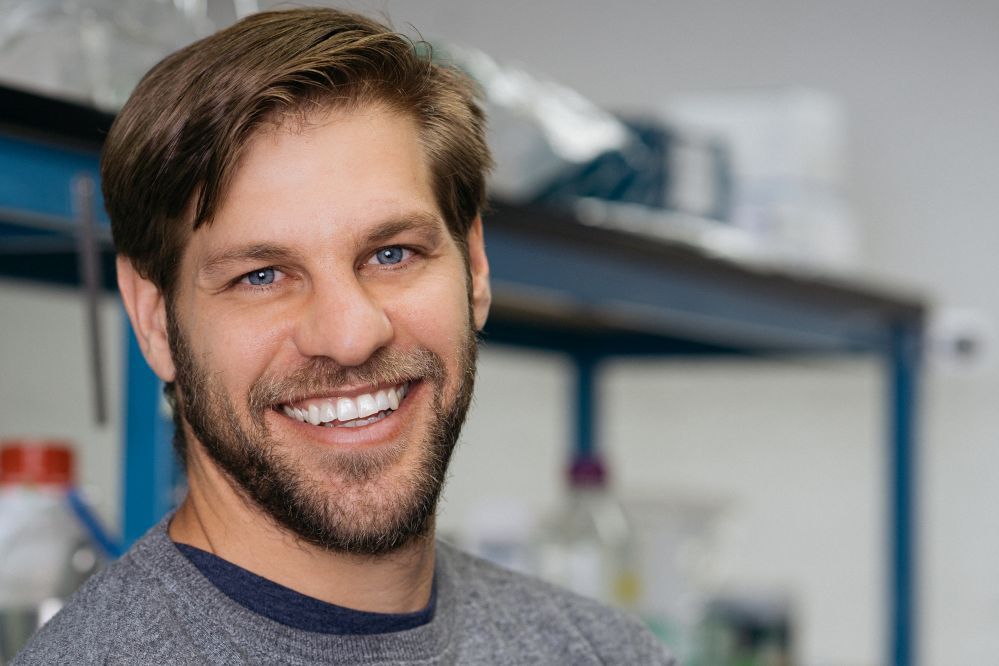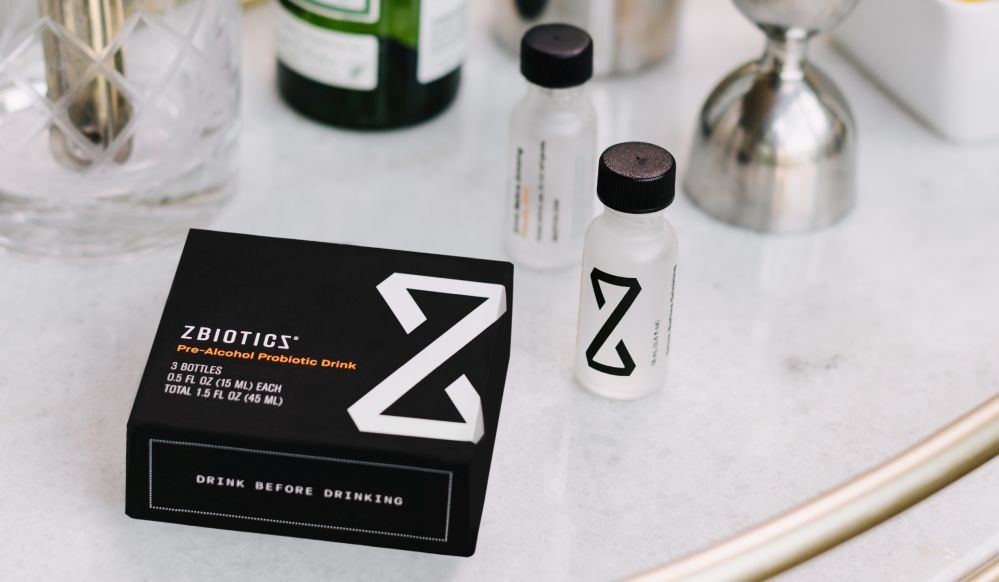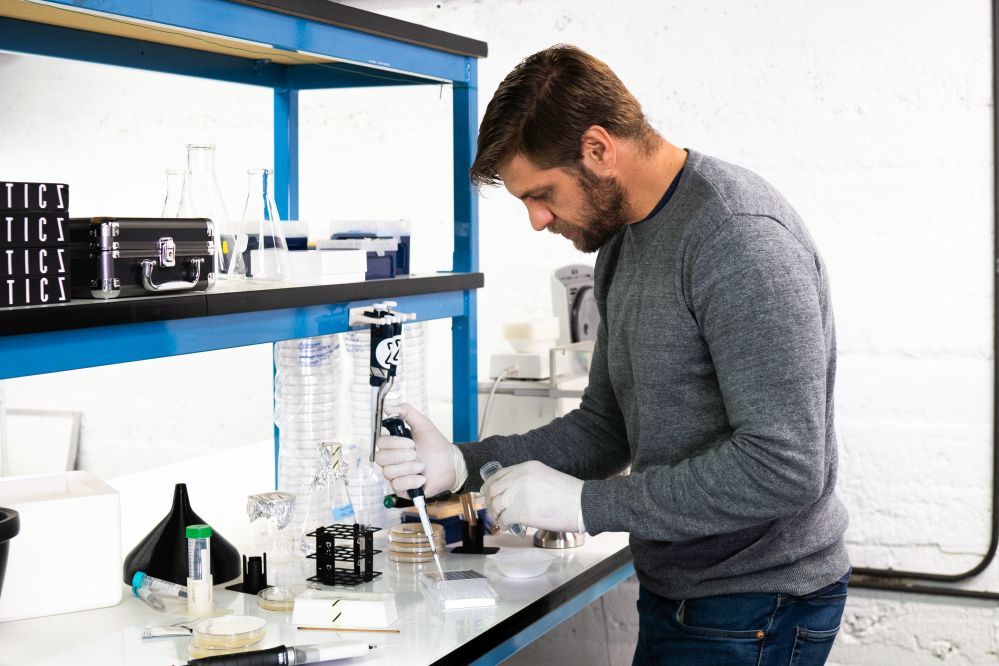Spoiler alert: Hangover ‘cures’ don’t work, observes Dr. Zachary Abbott. If you’ve overindulged the night before, Gatorade, herbal remedies and B vitamins won’t stop you feeling like death warmed up the next morning. But a shot of ZBiotics just might.
Which doesn’t mean you can down a bottle of Jack Daniels or 10 pints of beer consequence-free, says Abbott (catchphrase: ‘We’re into science, not science fiction’), but “If you drink ZBiotics before you drink alcohol, you wake up the next day feeling better than you would have felt otherwise.’
So how does it work?
The liver is pretty good at producing enzymes that break down alcohol into acetaldehyde and then convert it into acetate (basically vinegar). However, the gut—where some alcohol is also metabolized—does not do this quite as efficiently, says Abbott. Which is where ZBiotics comes in.
Founded by Abbott and Stephen Lamb in 2016, the San Francisco-based startup has engineered a microbe to express the enzyme that breaks down acetaldehyde by transferring said trait from the liver into a strain of bacteria (B. subtilis ZB183).
Rather than building a costly precision fermentation business to produce, purify, and sell the enzyme, ZBiotics sells the probiotic bacteria (via a shelf-stable shot sold direct-to-consumer), which then expresses the protein inside the gut.
And unlike most precision fermentation startups, ZBiotics is already profitable. To learn more about the journey, and what’s next, AgFunderNews (AFN) caught up with Abbott (ZA).

AFN: Give us the 60-second origins story…
ZA: The seed of the idea came from before I did my PhD [in microbiology and immunology] when I was working at an HIV lab at UC Davis and I heard a talk about protein engineering that made me really excited. But the challenge is that making these proteins is very difficult and expensive, so I had the idea that instead of giving you the protein, I could give you the protein factory, and we can do that much more efficiently and cheaply.
AFN: Why sell the protein factory, rather than the protein itself?
ZA: Proteins are unstable, but bacteria that we already use to make the proteins are much more stable. They’ve already evolved to pass through our bodies. And if we can engineer them to essentially make those proteins in our body continuously, it’s a much more efficient way to deliver protein, because growing bacteria is easy and cheap.
With precision fermentation, you engineer microbes such as bacteria to make a protein and then you purify out the protein from the bacteria, which is very expensive. Some of these proteins are also inherently unstable, and need to be stored chilled, or they’ll break down in your mouth and stomach before your body can utilize them in the gut.
But growing up the bacteria, we can do that for fractions of a penny a dose. We use a bacterial strain that is shelf-stable at room temperature, that can be orally ingested, and is already evolved to pass through your stomach acid unharmed. Then it gets into your gut, wakes up, and starts making this protein [the enzyme that breaks down acetaldehyde] and continually makes the protein in your body, which is a much more powerful mechanism of delivering a functional protein.
AFN: What makes the bacterial strain ‘wake up’ in the gut and start producing the target enzyme?
ZA: We use Bacillus subtilis, which is a spore former, so it goes into this endospore which is in a dormant state, where it’s very resilient, but it’s already got the machinery in place [to produce the target enzyme], and once it passes through the stomach acid and gets into your intestines, it senses that that’s a conducive environment, and it wakes up on its own.
We’ve engineered it so that while it’s actively in a vegetative state, it’s continually making protein.
AFN: How do you know it’s producing the enzyme in the gut?
ZA: We know from in vitro studies that the bacteria are capable of making a lot of this protein and we use gut-simulated conditions with the same pH and bile acids and so on. But of course, the proof is in the pudding. At the end of the day, consumers are getting a benefit and you see that in everything from consumer satisfaction surveys to repurchase rates, which are all consistent with the hypothesis that the product is functional in the gut.
AFN: But how big a contributor is buildup of acetaldehyde in the gut to hangovers in the first place?
ZA: When we first started, I think this issue was known but underappreciated. Most of the alcohol you drink is metabolized in the liver, which very efficiently breaks down ethanol into acetaldehyde and acetaldehyde into acetate. But what we see is that a small amount of the alcohol you drink is broken down directly in the gut, which is good at breaking it down into acetaldehyde, but not subsequently into acetate.
We actually see in the scientific literature that colonic levels of acetaldehyde are 5-10 times higher than blood levels. We also noticed that if you look at blood alcohol, you see it go up when you drink and then steadily go down to zero. But with blood acetaldehyde levels, the curve is a different shape. It goes up and then starts to come down, but then kind of plateaus out at a low level for a long time before it finally goes down.
And that’s in large part, we hypothesize, because the source of the acetaldehyde in the blood is the gut. It eventually makes it to the liver and it’s efficiently broken down, but by that point, it’s too late, it’s already had access to the systems of your body where it’s wreaking havoc.
So our hypothesis was that this gut-derived acetaldehyde was having an outsized effect on the way you feel the next day after drinking, and there was nothing addressing it.
AFN: What hangover remedies are currently on the market?
ZA: The products out there are mostly vitamins and hydration aids that we know have no effect. We know that dehydration has nothing to do with the way you feel after drinking; it’s been well established, but nobody had decoupled gut-derived acetaldehyde from the rest of the equation before.
AFN: What data did you need for safety?
ZA: We’re self-GRAS (generally recognized as safe), which required a 90-day rodent study, that showed no toxicity which, of course, you’d expect as this is bacteria that’s already well-studied and in your gut. The same applies to the enzyme it produces; it’s already made by your liver, so we’re combining two things we already know to be safe.
We then estimated the amount of acetaldehyde you’re going to be exposed to after a night of drinking and looked at the rate that our bacteria could break that down in gut-simulated conditions and saw it had a physiologically relevant rate of breakdown.
But again, what matters is that we have 95% plus customer satisfaction rates, very high repurchase rates, and high referral rates, which suggest that the product is working.

AFN: Why put your bacteria in a glass bottle?
ZA: We thought a lot about how to connect with the consumer in a category where there’s so much snake oil and junk. We also wanted a form factor that people could use in social settings, so we chose a liquid shot, not a pill. You don’t want to stand around at a party or in a bar and get out a bunch of pills.
We used a glass bottle because it’s recyclable but also signals high quality. Obviously shipping glass is harder than plastic, and we initially found that when it got cold and the liquid froze, it could shatter the bottle. But we did see that actually if we just put a little less liquid in the bottle, we solved the problem; you still get the same amount of bacteria.
AFN: So you’re ‘proudly GMO’?
ZA: It’s really signaling to folks that this is a different kind of product. There’s real technology in the bottle here. We put ‘Proudly GMO’ on every bottle and every box. We use modern biotechnology, and that’s why the product is good. Really connecting the technology to the benefit was really important to us in terms of our company mission.
What we’re trying to accomplish here is elevating the conversation around genetic engineering to make it a little bit more nuanced and rational. The first step is to make products that people want, that benefit the consumer.
AFN: When do you take the product and who is the target consumer?
ZA: Our customer is somebody who identifies as a healthy responsible person who invests in in their health and wellness, so they have all these healthy habits and routines, but maybe they’re going out with co-workers or to a wedding, and they’re going to have a few drinks.
They already pace themselves, they drink plenty of water and try to get plenty of sleep, not drink on an empty stomach, and so on, but they’ll still wake up the morning after and not feel 100%, so they’ll miss that morning workout. It tends to be people in their 30s and 40s.
As for timing, you can take it right before you start drinking, or a couple of hours before. But we’re very clear, this isn’t a get out of jail free card [if you go on a massive bender, you’ll feel lousy no matter what].
AFN: How much are consumers willing to pay?
ZA: [At between $9-12 a shot depending on how many you buy], our product is more expensive than pretty much anything else out there, but that’s because it actually works. From our conversations with people, the way they think about it, is, what’s your next day worth to you? How much would you spend on that greasy hamburger and Gatorade the next day?
It’s also about the opportunity cost loss in terms of not making that morning workout or not meeting up with your friends the next day. At that point $10 feels completely reasonable to many people.
AFN: When did you launch and what kind of reception have you had?
ZA: We launched direct to consumer in August 2019, things were going great and then in March 2020, Covid hit. But what was interesting was that we still saw customers coming in, as they were drinking at home, and sharing a bottle of wine with their significant other for dinner, and still wanted to go out and exercise the next day, for example. And then as things started to open back up, we started growing like crazy.
We started on Amazon in April this year, and it went well right out of the gate. We basically met our goal for the year in the first month.
For bricks and mortar retail, we’ve got a handful of places, some gyms, supplement shops, wellness shops, and we’re looking to scale those more. We’ve also had interest from hotels and high-end cocktail bars.
AFN: What IP do you have?
ZA: We have a granted patent that covers the genetic platform we built and the use case, a probiotic genetically engineered to break down acetaldehyde to help with the next day effects of drinking. We also have a pending patent on our [as yet undisclosed] second product.
AFN: How have you funded the business?
ZA: We’ve raised around $14 million and we’re doing great, we’ve still got plenty in the bank and we’ve been profitable in the last five months, so we have infinite runway as of right now.
AFN: Looking back, what did you get right, and what did you get wrong?
ZA: One thing we did right was hand out 10,000 samples personally, so before we ever launched a product, we had thousands of conversations with customers and everything was informed by those conversations.
As to what we did wrong, probably trying to do way too much early on, seeing every inbound that came across our desk as the next big thing from events to partnerships, when we had nowhere near the resources to execute. So there were all these things where we invested a ton of time and energy and they totally flopped.
I heard it 100 times, but it didn’t resonate at the time, but you have to maintain focus on the bread and butter. Forget the inbounds. You start to learn that these opportunities might be great, but they also might not be the right thing for you at the time.
AFN: What’s next in the world of designer probiotics?
ZA: We’re looking to launch our second product likely in the summer of 2024, so we’re not quite ready to announce what it is yet, but it’s nothing to do with alcohol or drinking; it’s a totally different space more related to gut health and the microbiome, which I’m really excited about as a microbiologist
It’s based on the same platform technology of a probiotic genetically engineered to perform a function in the gut, but it’s a totally novel function, and it does not exist on the market.
AFN: Why aren’t all the big probiotics players making genetically engineered probiotics?
ZA: I think they were afraid that consumers might reject them because of GMOs. It’s one thing if you walk into a grocery store and you have a choice between non GMO corn and GMO corn; the benefit is to the farmer, not you. But if you deliver a consumer benefit, people are interested.
We’re using cutting edge synthetic biology and biotechnology to make novel ingredients, package them, put them into products, brand them and sell them directly to the intended end user.




